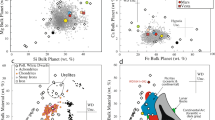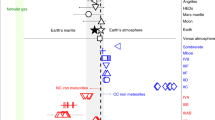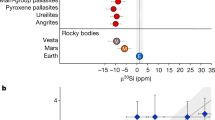Abstract
White dwarfs that accrete the debris of tidally disrupted asteroids1 provide the opportunity to measure the bulk composition of the building blocks, or fragments, of exoplanets2. This technique has established a diversity of compositions comparable to what is observed in the Solar System3, suggesting that the formation of rocky planets is a generic process4. The relative abundances of lithophile and siderophile elements within the planetary debris can be used to investigate whether exoplanets undergo differentiation5, yet the composition studies carried out so far lack unambiguous tracers of planetary crusts6. Here we report the detection of lithium in the atmospheres of four cool (<5,000 K) and old (cooling ages of 5–10 Gyr ago) metal-polluted white dwarfs, of which one also displays photospheric potassium. The relative abundances of these two elements with respect to sodium and calcium strongly suggest that all four white dwarfs have accreted fragments of planetary crusts. We detect an infrared excess in one of the systems, indicating that accretion from a circumstellar debris disk is ongoing. The main-sequence progenitor mass of this star was 4.8 ± 0.2 M⊙, demonstrating that rocky, differentiated planets may form around short-lived B-type stars.
This is a preview of subscription content, access via your institution
Access options
Access Nature and 54 other Nature Portfolio journals
Get Nature+, our best-value online-access subscription
$29.99 / 30 days
cancel any time
Subscribe to this journal
Receive 12 digital issues and online access to articles
$119.00 per year
only $9.92 per issue
Buy this article
- Purchase on Springer Link
- Instant access to full article PDF
Prices may be subject to local taxes which are calculated during checkout



Similar content being viewed by others
Data availability
The data that support the plots within this paper and other findings of this study are available from the ESO science archive facility, the GTC public archive, ING archive and SDSS database; or from the corresponding author upon reasonable request.
Code availability
The Koester model atmosphere and envelope codes are not publicly available, although details of their internal operation and input physics can be consulted from ref. 15.
References
Jura, M. A tidally disrupted asteroid around the white dwarf G29-38. Astrophys. J. Lett. 584, L91–L94 (2003).
Zuckerman, B., Koester, D., Melis, C., Hansen, B. M. & Jura, M. The chemical composition of an extrasolar minor planet. Astrophys. J. 671, 872–877 (2007).
Gänsicke, B. T. et al. The chemical diversity of exo-terrestrial planetary debris around white dwarfs. Mon. Not. R. Astron. Soc. 424, 333–347 (2012).
Doyle, A. E., Young, E. D., Klein, B., Zuckerman, B. & Schlichting, H. E. Oxygen fugacities of extrasolar rocks: evidence for an Earth-like geochemistry of exoplanets. Science 366, 356–359 (2019).
Zuckerman, B. et al. An aluminum/calcium-rich, iron-poor, white dwarf star: evidence for an extrasolar planetary lithosphere? Astrophys. J. 739, 101 (2011).
Bonsor, A. et al. Are exoplanetesimals differentiated? Mon. Not. R. Astron. Soc. 492, 2683–2697 (2020).
Gaia Collaboration et al. Gaia Data Release 2—summary of the contents and survey properties. Astron. Astrophys. 616, A1 (2018).
Gentile Fusillo, N. P. et al. A Gaia Data Release 2 catalogue of white dwarfs and a comparison with SDSS. Mon. Not. R. Astron. Soc. 482, 4570–4591 (2019).
Tremblay, P. E. et al. Gaia white dwarfs within 40 pc: I. Spectroscopic observations of new candidates. Mon. Not. R. Astron. Soc. 497, 130–145 (2020).
Hollands, M. A., Koester, D., Alekseev, V., Herbert, E. L. & Gänsicke, B. T. Cool DZ white dwarfs: I. Identification and spectral analysis. Mon. Not. R. Astron. Soc. 467, 4970–5000 (2017).
Harris, H. C. et al. An initial survey of white dwarfs in the Sloan Digital Sky Survey. Astron. J. 126, 1023–1040 (2003).
Lodders, K. Solar system abundances and condensation temperatures of the elements. Astrophys. J. 591, 1220–1247 (2003).
Debes, J. H., Walsh, K. J. & Stark, C. The link between planetary systems, dusty white dwarfs, and metal-polluted white dwarfs. Astrophys. J. 747, 148 (2012).
Petrovich, C. & Muñoz, D. J. Planetary engulfment as a trigger for white dwarf pollution. Astrophys. J. 834, 116 (2017).
Koester, D. White dwarf spectra and atmosphere models. Mem. Soc. Astron. Ital. 81, 921–931 (2010).
McDonough, W. in Earthquake Thermodynamics and Phase Transformation in the Earth’s Interior (eds Teisseyre, R. & Majewski, E.) 5–24 (Elsevier, 2000).
Rudnick, R. L. & Gao, S. in Treatise on Geochemistry Vol. 3, 1–56 (Elsevier, 2003).
Koester, D., Kepler, S. O. & Irwin, A. W. New white dwarf envelope models and diffusion—application to DQ white dwarfs. Astron. Astrophys. 635, A103 (2020).
Hollands, M. A., Gänsicke, B. T. & Koester, D. Cool DZ white dwarfs II: compositions and evolution of old remnant planetary systems. Mon. Not. R. Astron. Soc. 477, 93–111 (2018).
Lodders, K. & Fegley, B. Jr Chemistry of the Solar System (RSC, 2011).
Koester, D. Accretion and diffusion in white dwarfs. New diffusion timescales and applications to GD 362 and G 29-38. Astron. Astrophys. 498, 517–525 (2009).
Girven, J. et al. Constraints on the lifetimes of disks resulting from tidally destroyed rocky planetary bodies. Astrophys. J. 749, 154 (2012).
Eisenhardt, P. R. M. et al. The CatWISE preliminary catalog: motions from WISE and NEOWISE data. Astrophys. J. Suppl. 247, 69 (2020).
Debes, J. H. et al. A 3 Gyr white dwarf with warm dust discovered via the Backyard Worlds: Planet 9 citizen science project. Astrophys. J. Lett. 872, L25 (2019).
Rafikov, R. R. Metal accretion onto white dwarfs caused by Poynting-Robertson drag on their debris disks. Astrophys. J. Lett. 732, L3 (2011).
Farihi, J. Circumstellar debris and pollution at white dwarf stars. New Astron. Rev. 71, 9–34 (2016).
Cunningham, T., Tremblay, P.-E., Freytag, B., Ludwig, H.-G. & Koester, D. Convective overshoot and macroscopic diffusion in pure-hydrogen-atmosphere white dwarfs. Mon. Not. R. Astron. Soc. 488, 2503–2522 (2019).
Sato, B. et al. Substellar companions to seven evolved intermediate-mass stars. Publ. Astron. Soc. Jpn 64, 135 (2012).
Veras, D. et al. Constraining planet formation around 6-8 M⊙ stars. Mon. Not. R. Astron. Soc. 493, 765–775 (2020).
Cummings, J. D., Kalirai, J. S., Tremblay, P. E., Ramirez-Ruiz, E. & Choi, J. The white dwarf initial-final mass relation for progenitor stars from 0.85 to 7.5 M⊙. Astrophys. J. 866, 21 (2018).
Aguilera-Gómez, C., Chanamé, J., Pinsonneault, M. H. & Carlberg, J. K. On lithium-rich red giants. I: engulfment of substellar companions. Astrophys. J. 829, 127 (2016).
Chen, G. et al. The GTC exoplanet transit spectroscopy survey. IX: detection of haze, Na, K, and Li in the super-Neptune WASP-127b. Astron. Astrophys. 616, A145 (2018).
Reid, I. N., Liebert, J. & Schmidt, G. D. Discovery of a magnetic DZ white dwarf with Zeeman-split lines of heavy elements. Astrophys. J. Lett. 550, L61–L63 (2001).
Smette, A. et al. Molecfit: a general tool for telluric absorption correction. I: method and application to ESO instruments. Astron. Astrophys. 576, A77 (2015).
Kausch, W. et al. Molecfit: a general tool for telluric absorption correction. II: quantitative evaluation on ESO-VLT/X-Shooterspectra. Astron. Astrophys. 576, A78 (2015).
Blouin, S. et al. A new generation of cool white dwarf atmosphere models: III. WD J2356-209: accretion of a planetesimal with an unusual composition. Astrophys. J. 872, 188 (2019).
Blouin, S., Allard, N. F., Leininger, T., Gadéa, F. X. & Dufour, P. Line profiles of the calcium I resonance line in cool metal-polluted white dwarfs. Astrophys. J. 875, 137 (2019).
Chambers, K. C. et al. The Pan-STARRS1 Surveys. Preprint at https://arxiv.org/abs/1612.05560 (2016).
Alam, S. et al. The eleventh and twelfth data releases of the Sloan Digital Sky Survey: final data from SDSS-III. Astrophys. J. Suppl. 219, 12 (2015).
Wolf, C. et al. SkyMapper southern survey: first data release (DR1). Proc. Astron. Soc. Aust. 35, e010 (2018).
Cutri, R. M. et al. 2MASS All-Sky Catalog of Point Sources (Cutri+ 2003) II/246 (VizieR Online Data Catalog, 2003).
Skrutskie, M. F. et al. The Two Micron All Sky Survey (2MASS). Astron. J. 131, 1163–1183 (2006).
Valentinuzzi, T. et al. WINGS: a wide-field nearby galaxy-cluster survey. III: deep near-infrared photometry of 28 nearby clusters. Astron. Astrophys. 501, 851–864 (2009).
Moretti, A. et al. WINGS data release: a database of galaxies in nearby clusters. Astron. Astrophys. 564, A138 (2014).
Dye, S. et al. The UKIRT Hemisphere Survey: definition and J-band data release. Mon. Not. R. Astron. Soc. 473, 5113–5125 (2018).
Cutri, R. M. et al. AllWISE Data Release (Cutri+ 2013) II/328 (VizieR Online Data Catalog, 2013).
Fontaine, G., Brassard, P. & Bergeron, P. The potential of white dwarf cosmochronology. Publ. Astron. Soc. Pac. 113, 409–435 (2001).
Hollands, M. A., Gänsicke, B. T. & Koester, D. The incidence of magnetic fields in cool DZ white dwarfs. Mon. Not. R. Astron. Soc. 450, 681–690 (2015).
Gentile Fusillo, N. P. et al. Can magnetic fields suppress convection in the atmosphere of cool white dwarfs? A case study on WD2105-820. Mon. Not. R. Astron. Soc. 473, 3693–3699 (2018).
Tremblay, P. E. et al. On the evolution of magnetic white dwarfs. Astron. J. 812, 19 (2015).
Wright, E. L. et al. The Wide-field Infrared Survey Explorer (WISE): mission description and initial on-orbit performance. Astron. J. 140, 1868–1881 (2010).
Mainzer, A. et al. Preliminary results from NEOWISE: an enhancement to the Wide-field Infrared Survey Explorer for solar system science. Astrophys. J. 731, 53 (2011).
Blouin, S., Kowalski, P. M. & Dufour, P. Pressure distortion of the H2-He collision-induced absorption at the photosphere of cool white dwarf stars. Astrophys. J. 848, 36 (2017).
Blouin, S. Magnesium abundances in cool metal-polluted white dwarfs. Mon. Not. R. Astron. Soc. 496, 1881–1890 (2020).
Ferlet, R. & Dennefeld, M. Interstellar lithium and the 7Li/6Li ratio in diffuse clouds. Astron. Astrophys. 138, 303–310 (1984).
Ryabchikova, T. A., Piskunov, N. E., Kupka, F. & Weiss, W. W. The Vienna Atomic Line Database: present state and future development. Balt. Astron. 6, 244–247 (1997).
Ryabchikova, T. et al. A major upgrade of the VALD database. Phys. Scr. 90, 054005 (2015).
McCleery, J. et al. Gaia white dwarfs within 40 pc. II: the volume-limited Northern Hemisphere sample. Mon. Not. R. Astron. Soc. 499, 1890–1908 (2020).
Kilic, M. et al. The 100 pc white dwarf sample in the SDSS footprint. Astrophys. J. 898, 84 (2020).
Kowalski, P. M. & Saumon, D. Found: the missing blue opacity in atmosphere models of cool hydrogen white dwarfs. Astrophys. J. Lett. 651, L137–L140 (2006).
Karman, T. et al. Update of the HITRAN collision-induced absorption section. Icarus 328, 160–175 (2019).
Borysow, A., Jorgensen, U. G. & Zheng, C. Model atmospheres of cool, low-metallicity stars: the importance of collision-induced absorption. Astron. Astrophys. 324, 185–195 (1997).
Borysow, A., Jorgensen, U. G. & Fu, Y. High-temperature (1000-7000 K) collision-induced absorption of H2 pairs computed from the first principles, with application to cool and dense stellar atmospheres. J. Quant. Spectrosc. Radiat. Transf. 68, 235–255 (2001).
Kowalski, P. M. Infrared absorption of dense helium and its importance in the atmospheres of cool white dwarfs. Astron. Astrophys. 566, L8 (2014).
Rohrmann, R. D., Althaus, L. G. & Kepler, S. O. Lyman α wing absorption in cool white dwarf stars. Mon. Not. R. Astron. Soc. 411, 781–791 (2011).
Tremblay, P.-E., Ludwig, H.-G., Steffen, M. & Freytag, B. Spectroscopic analysis of DA white dwarfs with 3D model atmospheres. Astron. Astrophys. 559, A104 (2013).
Marigo, P. et al. Carbon star formation as seen through the non-monotonic initial-final mass relation. Nat. Astron. 4, 1102–1110 (2020).
Hurley, J. R., Pols, O. R. & Tout, C. A. Comprehensive analytic formulae for stellar evolution as a function of mass and metallicity. Mon. Not. R. Astron. Soc. 315, 543–569 (2000).
Oppenheimer, B. R., Hambly, N. C., Digby, A. P., Hodgkin, S. T. & Saumon, D. Direct detection of galactic halo dark matter. Science 292, 698–702 (2001).
Seabroke, G. M. & Gilmore, G. Revisiting the relations: galactic thin disc age-velocity dispersion relation. Mon. Not. R. Astron. Soc. 380, 1348–1368 (2007).
Kilic, M. et al. The age of the galactic stellar halo from Gaia white dwarfs. Mon. Not. R. Astron. Soc. 482, 965–979 (2019).
Fantin, N. J. et al. The Canada-France imaging survey: reconstructing the Milky Way star formation history from its white dwarf population. Astrophys. J. 887, 148 (2019).
Feltzing, S., Holmberg, J. & Hurley, J. R. The solar neighbourhood age-metallicity relation—does it exist? Astron. Astrophys. 377, 911–924 (2001).
Casagrande, L. et al. New constraints on the chemical evolution of the solar neighbourhood and galactic disc(s). Improved astrophysical parameters for the Geneva-Copenhagen Survey. Astron. Astrophys. 530, A138 (2011).
Acknowledgements
M.A.H. and P.-E.T. acknowledge useful discussions with H.-G. Ludwig and M. Steffen regarding neutral broadening of lithium lines. We also acknowledge J. McCleery for maintaining a database of 40 pc white dwarf spectra. M.A.H. and D.K. acknowledge atomic data from T. Leininger used for the Ca i unified profile. This research received funding from the European Research Council under the European Union’s Horizon 2020 research and innovation programme number 677706 (WD3D). B.T.G. was supported by the UK STFC under grant number ST/T000406/1 and a Leverhulme Research Fellowship. Funding for the Sloan Digital Sky Survey IV (www.sdss.org) was provided by the Alfred P. Sloan Foundation, the US Department of Energy Office of Science and the participating institutions. Based on observations collected at the European Organisation for Astronomical Research in the Southern Hemisphere under ESO programme 0102.C-0351. This article is based on observations (programme ITP08) made in the Observatorios de Canarias del IAC with the WHT operated on the island of La Palma by the Isaac Newton Group of Telescopes in the Observatorio del Roque de los Muchachos and with the Gran Telescopio Canarias (GTC), installed at the Spanish Observatorio del Roque de los Muchachos of the Instituto de Astrofísica de Canarias, on the island of La Palma.
Author information
Authors and Affiliations
Contributions
M.A.H. performed data reduction, analysis and interpretation and wrote the majority of the text. P.-E.T. and B.T.G. contributed to the data interpretation and writing of the article. D.K. developed the model atmosphere code used for the analysis. N.P.G.-F. contributed to the data reduction and analysis of photometric data.
Corresponding author
Ethics declarations
Competing interests
The authors declare no competing interests.
Additional information
Peer review information Nature Astronomy thanks the anonymous reviewers for their contribution to the peer review of this work.
Publisher’s note Springer Nature remains neutral with regard to jurisdictional claims in published maps and institutional affiliations.
Extended data
Extended Data Fig. 1 Astrometry and photometry for the four lithium-rich white dwarfs.
Pan-STARRS, SDSS and SkyMapper photometry are given in the AB-system, with the remainder in the Vega system. Positions are given in the J2015.5 epoch.
Extended Data Fig. 2 Atmospheric parameters for the four white dwarfs with photospheric lithium.
The abundances are in base 10 in terms of number ratio.
Extended Data Fig. 3 Best fitting models compared with the spectra and photometry of the four lithium-bearing white dwarfs.
In the right panel for WD J2317+1830, the disk model and white dwarf plus disk model are indicated by dotted and dashed curves, respectively. The spectrum of SDSS J1330+6435 has been smoothed with a Gaussian with a full width half maximum of 5 Å. Error bars correspond to 1σ uncertainties.
Extended Data Fig. 4 White dwarf envelope parameters for our sample.
The first row indicates the fractional convection zone mass. In subsequent rows, pairs correspond to the sinking timescale at the base of the convection zone in years, and (where abundances were determined) the elemental mass in the convection zone in g, i.e. (τZ/yr, mZ/g). Diffusion timescales are given for all elements commonly considered in white dwarf planetary abundance studies. The final row, ‘crust’, provides estimates for the total material within the white dwarf convection zones, assuming a continental crust composition, scaled from the Na masses.
Extended Data Fig. 5 SDSS spectra of three additional cool DZs with strong metal absorption features.
Lithium lines are not detected for any of these stars. Spectra have been smoothed by a Gaussian with a full width half maximum of 3 Å for clarity.
Supplementary information
Supplementary Information
Supplementary Figs. 1 and 2 and Tables 1 and 2.
Rights and permissions
About this article
Cite this article
Hollands, M.A., Tremblay, PE., Gänsicke, B.T. et al. Alkali metals in white dwarf atmospheres as tracers of ancient planetary crusts. Nat Astron 5, 451–459 (2021). https://doi.org/10.1038/s41550-020-01296-7
Received:
Accepted:
Published:
Issue Date:
DOI: https://doi.org/10.1038/s41550-020-01296-7
This article is cited by
-
A rotating white dwarf shows different compositions on its opposite faces
Nature (2023)
-
Rapid formation of exoplanetesimals revealed by white dwarfs
Nature Astronomy (2022)
-
Propagatory dynamics of nucleus-acoustic waves excited in gyrogravitating degenerate quantum plasmas electrostatically confined in curved geometry
Scientific Reports (2021)
-
Polluted white dwarfs reveal exotic mantle rock types on exoplanets in our solar neighborhood
Nature Communications (2021)
-
Dynamics of Positron Scattering from Lithium, Sodium and Potassium Atoms in Quantum Plasmas
Few-Body Systems (2021)



